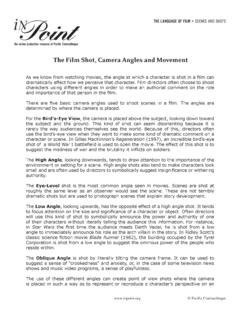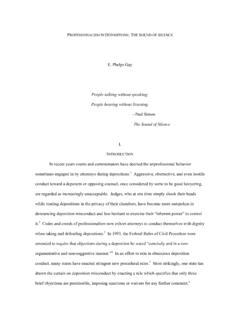Transcription of Sound in Filmmaking - The Cinematheque
1 Pacific Cin math que the on-line production resource at Pacific Cin math queTHE LANGUAGE OF in Filmmaking Sound refers to everything we hear in a movie words, Sound effects, and music. Sound is used in lm to heighten a mood, provide us with information about the location of a scene, advance the plot, and tell us about the characters in the are two categories of Sound in lm: Diegetic and Non-Diegetic. Diegetic Sound refers to all those audio elements that come from sources inside the world we see on the screen, including dialogue, doors slamming, footsteps, etc. Non-Diegetic Sound refers to all those audio elements that come from outside of the ctional world we see on screen, including the musical score and Sound effects like the screeches in the shower scene in Psycho.
2 How do Sound Effects help to Shape a Film? Sound effects can be used to add mood or atmosphere to a lm by creating a soundscape that accents or adds another layer of meaning to the images on the screen. Pitch, tempo, and volume may be altered to indicate how the lmmaker expects the audience to respond to a given noise. For instance, high-pitched sounds, including screams or squealing tires, help to create a sense of anxiety, while low-pitched sounds, including the sounds of waves or the swinging of a door, can be used to create a sense of calm or the most interesting use of Sound in a movie is the very absence of it: silence. At key points in a lm, directors may use silence in much the same way that they would use a freeze frame. Both tend to arrest the audience s attention to highlight some action or change in story direction.
3 Silence can be used to build up a scene s intensity or to foreshadow impending doom. In recent years, special Sound effects have been added to movies in order to heighten the lm experience. Many of these Sound effects, including explosions, phaser blasts, wind, and animal sounds are drawn from computer Sound effects libraries and are added to a lm after the movie has been shot. Besides creating louder and more dramatic movies, these effects have tended to draw more attention to movie Sound . With advancements in surround Sound , Sound effects have developed a more directional element, appearing to come from a speci c place or direction. This directional quality of Sound (alongside elements such as echoes) enhances a three-dimensional sense of space in the LANGUAGE OF FILM Sound IN Filmmaking Pacific Cin math quethe on-line production resource at Pacific Cin math quePAGE: Does Music Help to Shape a Film?
4 If we step back and think about it, music is one of the most peculiar conventions in movies. No one questions that music should be a part of movies because we ve all grown used to the idea that, in a movie, when two people kiss, we should hear music in the background. Or when the platoon attacks the beach, a symphony should provide the inspiration behind their assault. Of course, no one has a soundtrack accompanying their real lives. But in movies we not only accept this convention, we demand can be used for a number of effects in a movie. The most obvious way music scores are used is to guide the emotional response of the audience. They provide clues, or, in most cases, huge signposts, that tell audiences how the lmmaker wants them to react to a given directors play against our expectations and use music in ways we might not expect.
5 Stanley Kubrick shocked audiences when he used Singin in the Rain as the backdrop to a horrible rape scene in A Clockwork Orange (1971).Music can also provide an overture for a movie when it s used as the backdrop for the opening credits. The brassy theme music composed by John Williams for Star Wars is one famous and often-parodied some instances, directors use music to foreshadow upcoming events. In horror movies, for example, the score is often used to build up tension and suspense just before the monster attacks one of its , music can be used to shape the ethnic or cultural context of a Does the Spoken Word Help to Shape a Film?In addition to giving voice to the characters in a movie, two of the more interesting ways the spoken word can shape a movie are through voice-overs and by providing subtext to a are typically used in documentary lms, although they occasionally turn up in ction lms such as the original Blade Runner (1982), to provide background to a story or to help move a story from one set of events to another.
6 The on-line production resource at Pacific Cin math que Pacific Cin math queTHE LANGUAGE OF FILM Sound IN FILMMAKINGPAGE: well, voice-overs can be unobtrusive. Used poorly, voice-overs can often seem like the voice of god , bringing forth wisdom audiences are supposed to accept unquestioningly. For this reason, some lmmakers refuse to use voice-overs in their lms to let audiences have more freedom in determining what the meaning of the lm all know from our own personal conversations that there is often a subtext to the words we hear. Subtext means there is an implicit meaning standing behind the language we actually hear. In lm, actors use this element of language to shape a scene without actually saying what they , some actors are known for their distinctive voices which have helped de ne the characters they play.
7 Marilyn Monroe is remembered for her high-pitched breathy voice, which gave a slightly ditzy feel to many of her chracters, while John Malkovich has a distant, aloof, and direct manner of speech which helps to give a sinister edge to many of his best on-screen and adapted from Visual Storytelling and the Grammar of Filmmaking , Part II Study Gui










